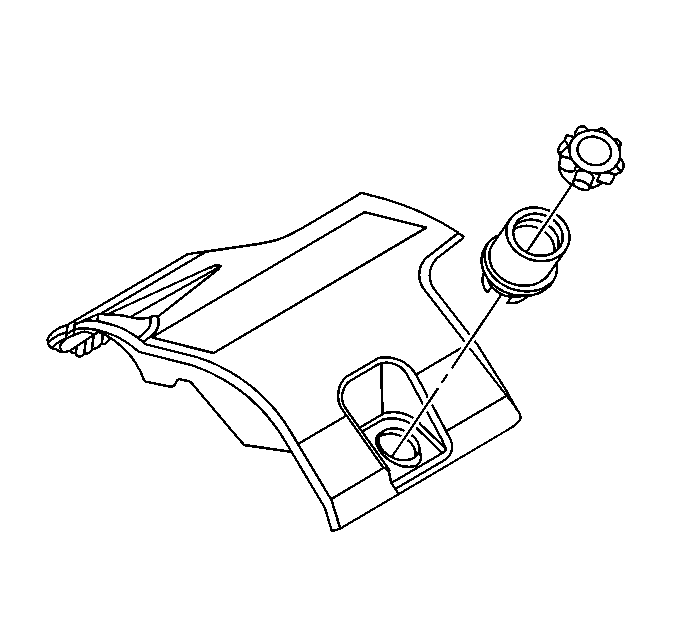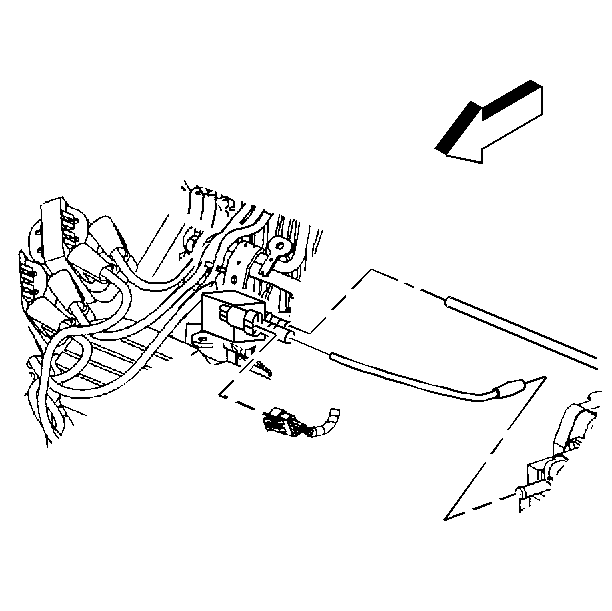Evaporative Emission System Hoses/Pipes Replacement Engine VIN K
Removal Procedure
- Remove the fuel injector sight shield. Refer to Fuel Injector Sight Shield Replacement in Engine Mechanical.
- Remove the hardware retaining the EVAP pipe if applicable.
- Inspect the location of the attaching hardware for installation.
- Remove the EVAP pipe/hose.
- Inspect the pipe/hose for bends, kinks, and cracks.
- Replace the pipes/hoses as required.


Installation Procedure
- Install the EVAP pipe/hose.
- Install the hardware retaining the EVAP pipe/hose.
- Install the fuel injector sight shield. Refer to Fuel Injector Sight Shield Replacement in Engine Mechanical.

Notice: Properly secure the EVAP pipe in order to prevent chafing of the pipe.

Evaporative Emission System Hoses/Pipes Replacement Engine VIN 1
Removal Procedure
Notice: Do Not attempt to repair the EVAP pipes or the connecting hoses. Replace the damaged EVAP pipes or the connecting hoses are damaged. If the nylon EVAP pipe becomes kinked and cannot be straightened, it must be replaced.
- Remove the fuel injector sight shield. Refer to Fuel Injector Sight Shield Replacement in Engine Mechanical.
- Remove the hardware retaining the EVAP pipe/hose (4).
- Inspect the location of the attaching hardware for installation.
- Remove the EVAP pipe/hose (5).
- Inspect the pipe/hose for bends, kinks, and cracks.
- Replace the pipes/hose as required.


Installation Procedure
- Install the EVAP pipe/hose (5).
- Install the hardware retaining the EVAP pipe/hose (4).
- Install the fuel injector sight shield. Refer to Fuel Injector Sight Shield Replacement in Engine Mechanical.

Notice: Properly secure the EVAP pipe in order to prevent chafing of the pipe.
Notice: Use the correct fastener in the correct location. Replacement fasteners must be the correct part number for that application. Fasteners requiring replacement or fasteners requiring the use of thread locking compound or sealant are identified in the service procedure. Do not use paints, lubricants, or corrosion inhibitors on fasteners or fastener joint surfaces unless specified. These coatings affect fastener torque and joint clamping force and may damage the fastener. Use the correct tightening sequence and specifications when installing fasteners in order to avoid damage to parts and systems.
Evaporative Emission System Hoses/Pipes Replacement Canister/Fuel Tank
Removal Procedure
Caution: In order to Reduce the Risk of Fire and Personal Injury:
• If nylon fuel pipes are nicked, scratched or damaged during installation,
Do Not attempt to repair the sections of the nylon fuel pipes. Replace them. • When installing new fuel pipes, Do Not hammer directly on the
fuel harness body clips as it may damage the nylon pipes resulting in a possible
fuel leak. • Always cover nylon vapor pipes with a wet towel before using a
torch near them. Also, never expose the vehicle to temperatures higher than
115°C (239°F) for more than one hour, or more than 90°C (194°F)
for any extended period. • Before connecting fuel pipe fittings, always apply a few drops
of clean engine oil to the male pipe ends. This will ensure proper reconnection
and prevent a possible fuel leak. (During normal operation, the O-rings located
in the female connector will swell and may prevent proper reconnection if
not lubricated.)
- Remove the fuel tank (5). Refer to Fuel Tank Replacement .
- Disconnect the EVAP vent hose/pipe (1) from the fill limiter vent valve.
- Remove the EVAP vent hose/pipe from the fuel tank (5).

Installation Procedure
- Position the EVAP vent hose/pipe (1) on the fuel tank (5).
- Connect the EVAP vent hose/pipe (1) to the fuel limiter vent valve.
- Install the fuel tank. Refer to Fuel Tank Replacement .
- Lower the vehicle.

